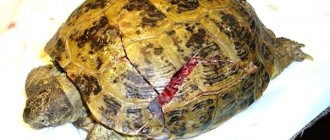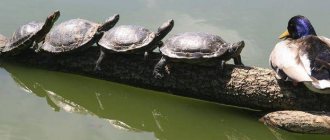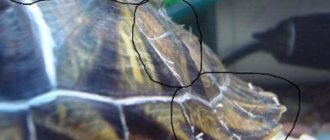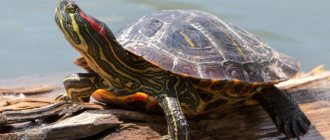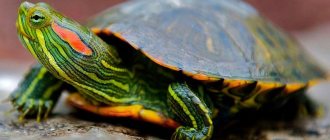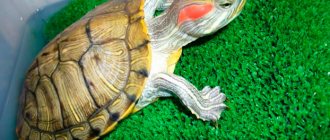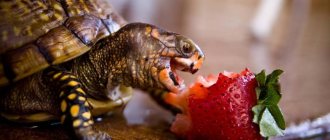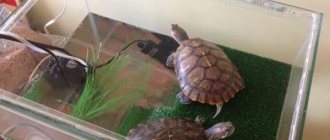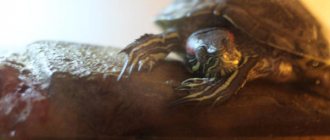Soft shell is a symptom of calcium and vitamin D3 deficiency
Often the presence of a softened shell in an amphibian is accompanied by some other symptoms: redness of the eyes, the appearance of small tubercles and swellings on the protective shell, increased body temperature, bending of the edges of the shell.
The above symptoms can be a consequence of many diseases, namely abnormal thyroid function and intestinal dysfunction. The hardness of a turtle shell is directly affected by the amount of calcium that circulates in the animal's body. It is with a deficiency of this element that deformation of the shell and other symptoms occur. A turtle in this condition cannot be left without treatment, otherwise over time its skull bones will become deformed and the animal will not be able to feed normally.
Calcium deficiency can be caused by a malfunction of the intestines or kidneys, as a result of which the rate of calcium absorption in the amphibian’s body is significantly reduced. Lack of ultraviolet radiation and, as a result, vitamin D deficiency can also lead to softening of the shell in a pet.
Description
The low carapace (carapace) is almost oval; if you look at it from above, you can see that the width in the back is slightly wider than in the front. The length of the shell is 20 cm or more in adult large turtles. Since water has always been the key habitat for turtles, the carapace scutes naturally fit perfectly together. In terms of their structure, the carapace and plastron are completely streamlined and have no protrusions. Large claws are located on the legs, small membranes are located between the toes. The claws of a swamp turtle can easily tear prey apart and can significantly scratch your hand. The tail of this turtle is relatively long, can reach 3/4 of the length of the carapace (about 12 cm) and during swimming it takes part as an auxiliary rudder during any turns (the main steering is carried out by the legs) and as a counterweight that holds the turtle in the required position during maneuvers. The carapace usually has a dark olive, dark green, sometimes almost black color, the plastron is light, yellowish. The shell, neck, head, legs are covered with small light spots. Often females have yellow eyes, while males are slightly reddish. Females have slightly shorter tails than males.
How to cure a pet?
If your turtle exhibits similar symptoms, you can try to take some measures yourself. In summer and warm spring, the pet can be taken out in an aquarium to the balcony or outside and placed in the sun. It is important that direct sunlight does not fall directly on the animal, but illuminates the aquarium well.
During cloudy seasons, in autumn and winter, an aquarium with a turtle should be placed under an ultraviolet lamp for a while, having previously covered the turtle’s eyes with a plaster. This must be done to ensure that radiation and bright light do not damage the organs of vision.
The turtle's diet should be reconsidered: you can add multivitamin complexes containing vitamin D and calcium to it. Shrimp can be a natural source of calcium for turtles. Hard-shell shellfish or minced fish with bones should be added to the animal’s diet.
But if the disease is in an advanced form or the measures taken have not brought the desired result, then the amphibian should be taken to a veterinarian. The doctor will administer a course of injections with vitamin complexes and the condition and appearance of the red-eared slider will improve significantly.
Preventing the disease
To avoid debilitating treatment, it is recommended to follow the rules of feeding and maintenance from the first days of meeting your pet. They are quite simple:
- The diet is selected of high quality, appropriate for the reptile. Food for cats and dogs is absolutely not suitable. Nutrition should include vitamin and mineral supplements, crushed eggshells or bone meal.
- The terrarium is chosen to be spacious and not restrict movement.
- A filter is connected to purify the water.
- In addition to natural lighting, an ultraviolet lamp is installed to maintain the temperature.
- To care for the shell, bathing and rubbing with olive oil are used.
By the way, in natural living conditions, turtles are practically not susceptible to rickets. In other words, a pet’s illness often arises from a lack of attention from the owner. Just take a little more care of your pet, and he will always be healthy.
Preventive measures
The best way to prevent the development of the disease is its prevention. To prevent the red-eared turtle from starting to soften its shell, it is necessary to sunbathe the animal several times a week. A good way to prevent calcium deficiency is to add crushed eggshells to your turtle's daily food several times a week. In winter, when the days outside are cloudy, the turtle needs to be given a solution of vitamin D-3. 3 drops of vitamin D for an adult turtle 2 times a month will completely prevent the development of rickets. The vitamin injection can be given into lumps of food or injected into the animal’s mouth using a medical syringe.
Following the above recommendations is an easy way to keep your turtle healthy. However, if the softening of the shell has already begun, the necessary measures should be taken. After all, rickets, a softening of the shell, can lead to the death of the animal.
Treatment
Rickets is a rather insidious disease. Progressing slowly, the disease gradually destroys the animal’s bones and the body as a whole, which causes unbearable suffering to the pet. Lack of timely treatment leads to the death of the turtle. Medications are prescribed for therapy. The dosage depends on the degree of damage:
First of all, consult your doctor. At stages 1-2 of rickets, a 10% solution of calcium gluconate is administered subcutaneously or intramuscularly, 15 ml per kilogram of the pet’s weight daily for two weeks.
1 ml of Panangin is administered orally every other day for 10 days. Mineral supplements are added to the diet. Daily irradiation with a UV lamp for 10 hours is mandatory.
For treatment of stages 3-4, it is recommended to consult a doctor for inpatient observation. Independent actions are unacceptable due to the risk of an incorrectly selected dosage, which leads to the death of the pet.
Pond slider
The taxonomy of the red-eared turtle species is very confusing. Their shell is relatively flat. The young of these reptiles have a light green tint to their shell; with age, its color changes to light brown or olive, then patterns appear on it that look like vertical yellow stripes, which are especially noticeable in water. Behind the eye of the red-eared turtle there is an elongated red spot. It is thanks to him that it owes its name. Stripes of white and light green colors are observed on the head, neck and limbs of the reptile.
Subcutaneous administration of drugs
Medicines that are not characterized by an irritating effect are perfectly administered subcutaneously.
This process is carried out under the skin at the base of the shoulder or thigh on the medial side. If the leg extends without problems, then the medicine is administered in the area where the inguinal notch of the shell is covered, or in the area where the thigh ends. If this cannot be done, then the medicine is injected at the base of the shell, above the retracted paw. Moreover, the needle is not inserted deeply.
If the turtle is severely dehydrated, then it is not recommended to stab it in the area of the inguinal fossa, since the wall of the bladder may be at a close distance from the skin.
Associated problems with shell diseases in turtles
In addition to the fact that the shell of turtles is deformed and its consistency changes, animals may experience spontaneous fractures of the limbs, bleeding, and the cloaca may fall out. The owners notice that the turtle’s gait is deformed; it seems to move only on raised front legs, while the hind legs simply drag behind it as a result of paresis. If you have an aquatic turtle, you can observe how it cannot get out onto its raft for a long time, and if the terrarium is not equipped with a gentle slope, it may even drown. The beak of turtles begins to resemble a duck's in shape, because the shape of the bite changes, this in turn limits the turtle in terms of nutrition. If the disease is advanced, death may occur from acute heart failure or pulmonary edema.
Arrangement of the aquarium
Maintenance and care do not require a special approach, but you should always remember that turtles of this subspecies can grow up to 20 cm or more in length. Therefore, when arranging a home, this factor should be taken into account so that the turtle does not feel crowded. In this case, take an aquarium that is not tall and not wide, but long enough so that the space can be divided into two parts.
Despite the fact that this species of turtles (yellow-eared and red-eared) are related to aquatic ones, the turtle definitely needs land. You can organize the land in any available way: put a large stone on the bottom of the aquarium so that it looks out from the water or add some soil. In short, the main thing is that the land is above the water level, and the turtle can easily climb onto it. If there is enough space in the aquarium, then you can add soil and plant suitable plants, then the turtle will feel just like in natural conditions. In this case, there is a huge space for the flight of your imagination.
Why is this happening
During labor, even if it goes well, the newborn's head has to face a number of difficulties. Even an easy birth for the mother can be difficult for the baby: the baby walks head first, the bones of the mother’s pelvis, the muscles of the pelvic floor and the genital organs put pressure on his skull, so the delicate bones are subject to displacement.
It should be noted that the skull is not a single bone, it consists of many individual bones that are connected by sutures. The baby’s seams are still elastic, mobile, and not fully secured. This is what helps the bones of the skull move during childbirth, as if overlapping each other, changing the shape of the head and facilitating the birth process. This mechanism was invented by nature itself because the diameter of the newborn’s skull is larger than the diameter of the mother’s birth canal. After birth, the bones of the skull normally “straighten.” The head regains its normal shape.
Soft shell of sea turtles
This type of reptile is distinguished by a teardrop-shaped shell. This shape allows the pet to swim quickly. If it suddenly becomes pliable and soft, it means the owner has violated the conditions of detention. The reasons for the development of rickets are the same as in the red-eared species.
What to do if your turtle has a soft shell? Feed your pet correctly. Buy food with special additives and vitamins. Change the water in the terrarium regularly and be sure to install a high-quality filter. If there is no ultraviolet lamp, then choose a place for the turtle that is well illuminated by sunlight.
Trionix Chinese, appearance
The length of the animal at home varies between 20-25 cm, but in rare cases it grows up to 40 cm. The weight of an adult can reach 4.5 kg. Not long ago, a turtle weighing 11 kg and a shell length of about 50 cm was caught near Taiwan, but this is already an anomaly.
The Trionix shell is round, the edges are soft, with age it changes shape from round to elongated; by this characteristic the age of the animal can be determined. The upper, visible part of the shell is green-gray or green-brown in color to camouflage itself at the bottom. The ventral part of the shell is much lighter, yellow, pink and orange. There may be dark spots - this is normal.
Shell color
Each paw has five toes, which end in three long, sharp claws. The shape of the foot has the characteristic features of waterfowl - the toes are connected by membranes.
The neck is very long; if you hold a turtle by its shell, it can stretch its neck and bite.
Tortoise flexibility
By nature, this is a solitary predator; you should not keep several individuals together at home. Fights with limbs being bitten off will be inevitable.
Prevention methods
There is one truth that must be adhered to. She claims that it is easier to prevent a disease than to treat it. Therefore, in order not to have to undergo treatment, it is better to regularly carry out preventive measures, which is what experienced owners do. This is especially true when the animal has gastrointestinal disorders or the turtle has contracted an acute respiratory infection and its body spends a lot of energy fighting these ailments.
Prevention is carried out every few months, or maybe more often, depending on the conditions. As a preventative measure, you can use oak bark baths or etch the aquaterrarium with Methylene Blue.
Carrying out preventive measures does not in any way indicate that there is no need to keep the animal in normal conditions. Normal conditions are appropriate temperature conditions, cleanliness and an appropriate diet. Without these three components, it is unlikely that it will be possible to raise a healthy animal. After all, in addition to fungus, pets are also plagued by other, no less serious diseases. All of them are directly related to both nutrition and living conditions.
